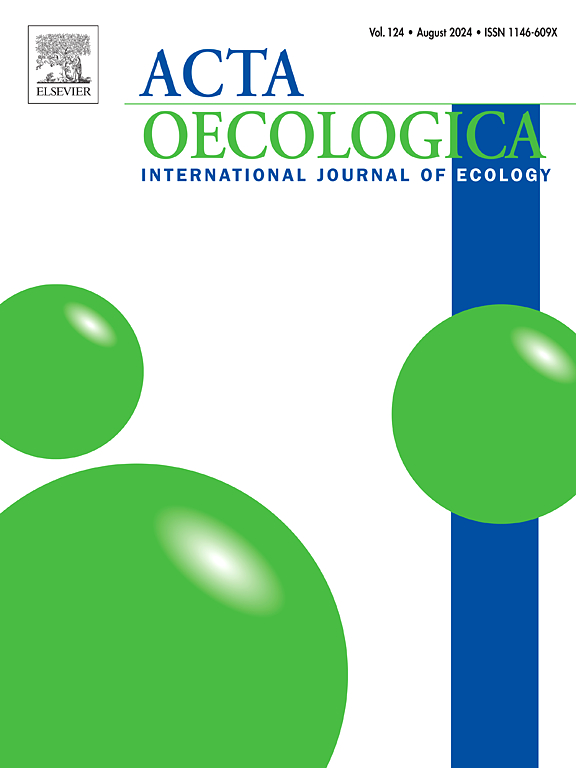Differences in foraging phenology dampen the impact of an invasive slug on ant-mediated seed dispersal of understory forest plants
IF 1.3
4区 环境科学与生态学
Q3 ECOLOGY
Acta Oecologica-International Journal of Ecology
Pub Date : 2024-11-30
DOI:10.1016/j.actao.2024.104041
引用次数: 0
Abstract
Seed-dispersal mutualisms are important ecosystem functions that, if disrupted, influence plant fitness and community structure. Anthropogenic stressors such as invasive species and climate change may independently or synergistically influence animal-mediated seed dispersal. Aphaenogaster sp. ants are the primary dispersers of myrmecochorous plants that produce diaspores or seeds with lipid-rich appendages (elaiosomes) that make them attractive to ants in eastern North American forest understories. An invasive slug, Arion sp., damages diaspores by consuming elaiosomes, rendering seeds unattractive to ants. Here, in one forest site, we examine if slugs negatively affect seed dispersal by assessing interactions between seed-dispersing ants and invasive slugs on four species of myrmecochores that release diaspores at different times. We performed an exclusion experiment, excluding slugs and ants to diaspores on depots, when diaspores of four myrmecochore species were released from fruits. We also conducted a similar experiment presenting diaspores of all species at one time in the field and slug preference trials in the lab to determine if particular myrmecochore species are vulnerable to the invasive slug. We found that slugs did not reduce dispersal by ants despite slugs damaging diaspores. This was because peak ant and slug activity differed, with slugs damaging most diaspores of early-dehiscing Sanguinaria canadensis, and ants dispersing most diaspores of later-dehiscing Trillium grandiflorum. When diaspores were presented at the same time, ants and slugs preferred the same species, T. grandiflorum. While we did not find overlap in the phenology of ant and slug interactions in this study, phenological interactions are likely context-dependent. Thus, high-preference species may be vulnerable to invasive slugs if interacting species overlap in different contexts, including under climate change.
觅食物候的差异抑制了入侵蛞蝓对林下植物抗媒介种子传播的影响
种子传播互性是重要的生态系统功能,如果被破坏,将影响植物适应性和群落结构。入侵物种和气候变化等人为压力源可能单独或协同影响动物介导的种子传播。在北美东部的森林林下,食蚜蚁是食蚜植物的主要传播者,这些食蚜植物产生具有富含脂质附属物(溶虫体)的孢子或种子,这使它们对蚂蚁具有吸引力。一种侵入性蛞蝓,Arion sp.,通过消耗种子体来破坏种子,使种子对蚂蚁没有吸引力。在这里,在一个森林站点,我们通过评估种子传播蚂蚁和入侵鼻涕虫在不同时间释放的四种myrmeco杂交种上的相互作用来研究鼻涕虫是否会对种子传播产生负面影响。我们对四种蜜桃属植物的孢子进行了排除实验,排除了蛞蝓和蚂蚁在贮藏库上的孢子。我们还进行了一个类似的实验,在野外同时展示了所有物种的多样性,并在实验室进行了蛞蝓偏好试验,以确定特定的myrmecochore物种是否容易受到入侵的蛞蝓的攻击。我们发现蛞蝓并没有减少蚂蚁的扩散,尽管它们破坏了扩散。这是因为蚂蚁和蛞蝓的峰值活性不同,蛞蝓破坏了早期开裂的加拿大血根(Sanguinaria canadensis)的大部分囊膜,而蚂蚁分散了后期开裂的桔梗(Trillium grandflorum)的大部分囊膜。当一水花同时出现时,蚂蚁和蛞蝓更倾向于同一种,T. grandflorum。虽然我们在这项研究中没有发现蚂蚁和蛞蝓相互作用的物候重叠,但物候相互作用可能依赖于环境。因此,如果相互作用的物种在不同的环境下重叠,包括在气候变化的情况下,高偏好物种可能容易受到入侵鼻涕虫的攻击。
本文章由计算机程序翻译,如有差异,请以英文原文为准。
求助全文
约1分钟内获得全文
求助全文
来源期刊
CiteScore
3.60
自引率
0.00%
发文量
57
审稿时长
>0 weeks
期刊介绍:
Acta Oecologica is venue for the publication of original research articles in ecology. We encourage studies in all areas of ecology, including ecosystem ecology, community ecology, population ecology, conservation ecology and evolutionary ecology. There is no bias with respect to taxon, biome or geographic area. Both theoretical and empirical papers are welcome, but combinations are particularly sought. Priority is given to papers based on explicitly stated hypotheses. Acta Oecologica also accepts review papers.

 求助内容:
求助内容: 应助结果提醒方式:
应助结果提醒方式:


